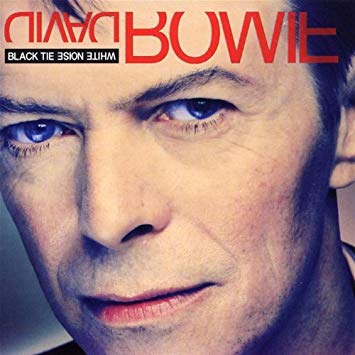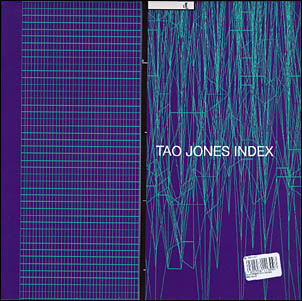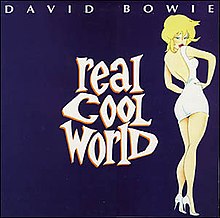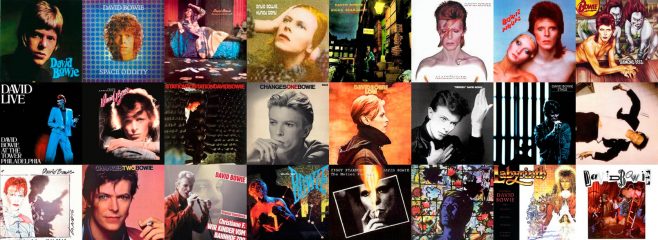
“Black Tie White Noise” is David Bowie’s 20th studio album and was originally released on 5th April 1993.
After Bowie’s (mis)adventures with Tin Machine, this album was seen by many as a return to form and a return to being the solo artist many fans craved. It was the first album that I remember that came with the initial label of being “his best album since 1980’s Scary Monsters and Super Creeps”, a label that many of his subsequent albums would also share.
The early 90’s was a period of some change for Bowie, not only did he decide to retire the Tin Machine project, but much more importantly, he met the woman of his dreams in Iman Abdulmajid who he would marry and remain happily so for the rest of his life. The album as such reflects much of this married bliss and is bookend with music that he wrote specifically for his wedding.
The album also marks a couple of key musical reunions. Firstly, after the relative commercial and critical disappointments that were his Tin Machine albums (and indeed some albums beforehand), Bowie was keen to get back to some form. Who better to turn to than Nile Rodgers who produced the killer commercial monster that was “Let’s Dance“. Although Rodgers’s influence is not as strong here as on “Let’s Dance”, the album has a certain “vibe”, a “catchy” quality that makes the album such a joy to listen to. The main difference here is that so many of the songs are of a better quality than those on “Let’s Dance”.
For me though, this album will always be remembered as the album where Bowie finally reunited after 20 long years with the great Mick Ronson (albeit on just one track), his “Spiders From Mars” sidekick who would so tragically pass away before the album was released. The resultant track “I Feel Free“, a cover of the Cream classic that Ziggy and the Spiders would play in their heyday is worth price of admission alone methinks.
The main musical influence on the album though is someone new to the Bowie universe, Lester Bowie (obviously no relation), who’s trumpet playing would provide the major musical theme throughout the album and gives the album a wonderful distinct dimension.
The album opens with the majestic instrumental “The Wedding“, written by Bowie to be played at his wedding. Starting with church bells, it quickly hits a groove that’s both incredible catchy but also romantic in nature. It really is quite a beautiful piece of music.
The next track “You’ve Been Around” is co-written with Reeves Gabrels, his Tin Machine cohort and features Gabrels on lead guitar (although barely in the mix to Bowie’s amusement and Gabrels annoyance), this being the only link between this album and Tin Machine. It has a killer bass line and features Lester Bowie at his best during the trumpet solo. Bowie’s vocal is somewhat distorted, which gives the song a certain eeriness that I’ve always liked. The ch-ch-ch-ch-changes line certainly brings back memories. Rodgers with his production work here has totally transformed a Tin Machine number into a funky, jiving piece that works rather well.
“I Feel Free” comes up next and has always been a bit of an emotional number for me as it reunited Bowie with Mick Ronson for the last time in the studio. I have a number of poor quality bootleg versions of this song dating back to 1972 when Bowie performed it with the Spiders From Mars, so it’s kinda nice that he revisited it again on this album. Again, it has that Rodgers inspired groove, but with Ronson’s guitar solo giving it that edginess in the later stages. Bowie’s vocals are much deeper than usual but absolutely divine. A nice way to musically say goodbye to each other.
Up next is the title track “Black Tie White Noise“, a duet with Al B. Sure! where they jointly lament the injustices on blacks living in the US. Bowie was horrified by the 1992 LA race riots that followed appalling attack on Rodney King and was motivated enough to write this tough appraisal of the white/black relationship in the US (sadly, little has changed in all these years). Bowie doesn’t usually tackle political issues with his song writing, but when he does he certainly does so with some bite. This is a truly great song with the joint vocals working perfectly together. The tough lyrics are a little at odds with the catchy, bass lead backing track which slightly disarms what is a powerful protest song. Again, Lester Bowie’s trumpet contribution works beautifully. This was the second single off the album and probably deserved to do better than it did (although it did reach the lofty heights of 76 in in Australian singles chart !!). See music video.

“Jump They Say” is one of the most brilliant of all Bowie songs, an all time top 20 entry and in my opinion perhaps the most under-rated single in his entire catalogue. Based in large part on the recent tragic suicide of his half-brother Terry, it’s a powerful piece where the driving rhythm, the catchy musical phrases, Lester Bowie’s trumpet and the astonishing vocal performance by Bowie all combine to make this epic Bowie masterpiece. Yes, I love this !! This was the lead-off single for the album and came with one of Bowie’s very best music videos, a wonderfully complex view of a corporate executive being driven to madness and eventual suicide by corporate greed and jealousy. If you have never this song before or seen the video, do yourself a favour by watching it here: music video. The video became the basis of a PC video game at the time, where you can edit the video yourself and listen to some Bowie interviews.

The brilliance continue on the next track “Nite Flights“, a cover of the Scott Walker classic who was a big influence on Bowie. I would rate this as perhaps the best cover Bowie has recorded, with the exception of the sublime “Wild Is The Wind” from “Station To Station”. It’s that good. Featuring a wonderful backing track, amazing synthesizers and atmospheric touches during the chorus and vocal breaks and again a brilliant vocal performance by Bowie, this is a true highlight of what Bowie could achieve in his criminally under-rated 90’s period. Nile Rodgers deserves much credit for putting all these components together so superbly.
This was most certainly the best side one of music Bowie has recorded since “Scary Monsters and Super Creeps”. It’s that good. Although the second half doesn’t quite match up to the same standard, there’s still much to enjoy.
The second half begins with “Pallas Athena“, another mainly instrumental heavily influenced I suspect by his recent marriage. It’s got that now familiar catchy Rodgers groove, with a bass line and drum beat that drives on and on and with perhaps a nod to the sounds he would explore further with the drum ‘n’ bass on the “Earthling” album. “God is on top of it all, that’s all” is the only repeated foreground lyric, delivered by what sounds like a black American preacher (but perhaps that’s just me). It was actually released as a 12″ dance single in some regions.

Up next comes “Miracle Goodnight“, clearly a love song to Iman. It’s a lovely little ditty, that is more keyboard based than much of the other material on the album. Bowie sings the song in a higher register than normal, which gives it that vulnerable vibe. It reminds me a little of his work during the Labyrinth soundtrack period. Released as the third single off the album, it featured a clever video of Bowie (looking a little like The Thin White Duke) at times surrounded by a hoard of women to which he shows no interest and at other times in a weird, jesters type outfit surrounded by mirrors. Oh, and there’s a cowgirl too. Yes, I don’t quite get it either. Watch music video.

We now reach the less interesting section of the album. “Don’t Let Me Down & Down” is a cover of a song by Tahra Mint Hembara (who?), a friend of Iman who liked a album of hers and suggested her new hubby should cover it. It’s a nice enough song, but it’s a little sedate and not up to the quality of the previous tracks on the album. There’s is an alternative version that contains an Indonesian vocal which strangely enough is actually an improvement on the album version.
“Looking For Lester” is another instrumental, a bouncy fun piece, written I can only assume to highlight the trumpet playing of Lester Bowie. It’s the closest Bowie has really gotten to that jazz feel, with Mike Garson no doubt another influence here, returning again on this track after nearly 20 years. His piano playing features more prominently near the end of the track. Garson would go on to feature heavily in future Bowie albums until near the very end.
“I Know It’s Gonna Happen Some Day” is the album low point for me, a cover of a song by Morrissey that featured on his recent “Your Arsenal” album (that was produced incidentally by Mick Ronson, hence the connection here). I’m no Smiths/Morrissey fan (sacrilege I know for someone who grew up in Manchester), but I just find his voice annoyingly whiny and here we have Bowie doing Morrissey doing Bowie. I much prefer Bowie doing Bowie. I even prefer Bowie’s cover of “God Only Knows” from “Tonight“. Enough said.
Happily, the album ends on a high with “The Wedding Song“, a reprise of the excellent opening instrumental, but this time with some yearning lyrics and a heartfelt vocal performance by Bowie (not too dissimilar to his vocals on the excellent “Untitled No 1” on his next “Buddha of Suburbia” album). Bowie produced some of his best work during his dark days, but this song and the album as a whole shows that Bowie is more than capable of producing some excellent material when life is chirpy and kind.
The album was seen as a returned to form by most fans and critics and debuted at No. 1 in the UK charts, his last No. 1 until “The Next Day” album in 2013. I have always loved this album and has a soft spot for me, in part because of the quality within and in part because of the various guest appearances.
The album has come out in various formats over the years, including a special 10th anniversary 2CD+DVD version that contains an extra CD of mainly remixes but includes two additional tracks worth a mention:
“Lucy Can’t Dance” is a bouncy, catchy, little ditty that I’ve always quite liked and would have rated as one of the better tracks had it appeared on either the “Tonight” or “Never Let Me Down” albums. It doesn’t quite fit in this album and one can see why it was shelved.
“Real Cool World” was recorded during these Nile Rodgers sessions, but was released prior to the album as a single and as part of the soundtrack to the movie “Cool World” (yes, I missed the movie as well). It’s all a bit ploddy with a basic drum beat and electronic flourishes but with little melody or anything to really make it particularly memorable. Bowie even sounds a little bored as he sings away. The fact it was Bowie’s first solo single for quite some years and that it only reach No. 53 on the UK charts suggests not many were taken with it.

Bowie didn’t tour the album (and wouldn’t tour again until the brilliant 1995 “Outside” tour), but he did release a somewhat bizarre 1 hour video (included in the 10th anniversary edition) where he discussed the album and mined 6 tracks from the album in a warehouse somewhere with some brights lights and a few hand held cameras. The six tracks selected were “You’ve Been Around”, “Nite Flights”, “Miracle Goodnight”, “Black Tie White Noise”, “I Feel Free” and “I Know It’s Gonna Happen Someday”. The interview/discussion sections are quite interesting and give some insights into the making of the album.
The album proved many of his critics wrong and highlighted that Bowie was far from a spent force and still had it in him to make some amazing new music. He would achieve even greater artistic success with some of his future albums, including the next album on my countdown. But that’s a story for another day.
Best Tracks: “Jump They Say”, “Nite Flights”, “Black Tie White Noise”
